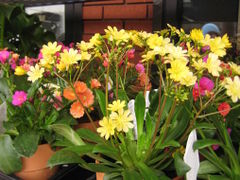Lewisia: Difference between revisions
No edit summary |
No edit summary |
||
| (One intermediate revision by the same user not shown) | |||
| Line 1: | Line 1: | ||
__NOTOC__{{Plantbox | __NOTOC__{{Plantbox | ||
| name = ''Lewisia'' | | name = ''Lewisia'' | ||
| Line 12: | Line 7: | ||
| origin = <!--- Mexico, S America, S Europe, garden, etc --> | | origin = <!--- Mexico, S America, S Europe, garden, etc --> | ||
| poisonous = <!--- indicate parts of plants which are known/thought to be poisonous --> | | poisonous = <!--- indicate parts of plants which are known/thought to be poisonous --> | ||
| lifespan = | | lifespan = perennial | ||
| exposure = <!--- full sun, part-sun, semi-shade, shade, indoors, bright filtered (you may list more than 1) --> | | exposure = <!--- full sun, part-sun, semi-shade, shade, indoors, bright filtered (you may list more than 1) --> | ||
| water = <!--- frequent, regular, moderate, drought tolerant, let dry then soak --> | | water = <!--- frequent, regular, moderate, drought tolerant, let dry then soak --> | ||
| Line 21: | Line 16: | ||
| sunset_zones = <!--- eg. 8, 9, 12-24, not available --> | | sunset_zones = <!--- eg. 8, 9, 12-24, not available --> | ||
| color = IndianRed | | color = IndianRed | ||
| image = | | image = Lewisia-IMG 6721.JPG | ||
| image_width = 240px <!--- leave as 240px if horizontal orientation photo, or change to 180px if vertical --> | | image_width = 240px <!--- leave as 240px if horizontal orientation photo, or change to 180px if vertical --> | ||
| image_caption = <!--- eg. Cultivated freesias --> | | image_caption = <!--- eg. Cultivated freesias --> | ||
| familia = <!--- Family --> | | familia = <!--- Family --> | ||
| genus = Lewisia | | genus = Lewisia | ||
}} | }} | ||
{{ | {{Inc| | ||
Lewisia (named by Pursh for Capt. Meriwether Lewis, of the Lewis and Clark transcontinental expedition). Portulacaceae. Fleshy-leaved low perennials, bearing showy white, rose or red flowers. | |||
Plants acaulescent or nearly so, with thick and farinaceous caudex and root: leaves narrow, mostly clavate or spatulate or oblong, entire, rosulate at the apex of the short caudex (or corm in one species): flowers 1 to many, on scapes, often large and handsome; sepals 2-8, persistent; petals 3-16; stamens 5 to numerous, the anthors oblong to linear; style-branches slender, 3-8, with long stigmatic surfaces: fruits a circumscissile caps.; several- to many-seeded. —Species about a dozen, from Colo., Wyo., and Mont, westward. The genus has been variously defined; as here characterized, it includes Oreobroma and species that have been described under Calandrinia and Talinum. From Calandrinia, the genus is separated by style-branches often more than 3, and caps, circumscissile near the base rather than 3-valved from the apex. The cultivator's interest in lewisias centers chiefly in L. rediviva, which is grown in collections of succulents. The other species are very little known as cultured plants, although there appears to be an accelerated interest in them in recent years. They should make good rock-garden and alpine subjects. | |||
}} | |||
==Cultivation== | ==Cultivation== | ||
Latest revision as of 19:43, 23 September 2009
Lewisia {{{latin_name}}}
|
'
| ||||||||||||||||||||||||||||||||||||||||
|---|---|---|---|---|---|---|---|---|---|---|---|---|---|---|---|---|---|---|---|---|---|---|---|---|---|---|---|---|---|---|---|---|---|---|---|---|---|---|---|---|---|

|
|
| |||||||||||||||||||||||||||||||||||||||
| |||||||||||||||||||||||||||||||||||||||||
| Standard Cyclopedia of Horticulture |
|---|
|
Lewisia (named by Pursh for Capt. Meriwether Lewis, of the Lewis and Clark transcontinental expedition). Portulacaceae. Fleshy-leaved low perennials, bearing showy white, rose or red flowers. Plants acaulescent or nearly so, with thick and farinaceous caudex and root: leaves narrow, mostly clavate or spatulate or oblong, entire, rosulate at the apex of the short caudex (or corm in one species): flowers 1 to many, on scapes, often large and handsome; sepals 2-8, persistent; petals 3-16; stamens 5 to numerous, the anthors oblong to linear; style-branches slender, 3-8, with long stigmatic surfaces: fruits a circumscissile caps.; several- to many-seeded. —Species about a dozen, from Colo., Wyo., and Mont, westward. The genus has been variously defined; as here characterized, it includes Oreobroma and species that have been described under Calandrinia and Talinum. From Calandrinia, the genus is separated by style-branches often more than 3, and caps, circumscissile near the base rather than 3-valved from the apex. The cultivator's interest in lewisias centers chiefly in L. rediviva, which is grown in collections of succulents. The other species are very little known as cultured plants, although there appears to be an accelerated interest in them in recent years. They should make good rock-garden and alpine subjects.
|
Cultivation
| calendar? | ||
|---|---|---|
| January: | ||
| February: | ||
| March: | ||
| April: | ||
| May: | ||
| June: | ||
| July: | ||
| August: | ||
| September: | ||
| October: | ||
| November: | ||
| December: | ||
| Notes: | ||
- Do you have cultivation info on this plant? Edit this section!
Propagation
- Do you have propagation info on this plant? Edit this section!
Pests and diseases
- Do you have pest and disease info on this plant? Edit this section!
Species
Gallery
If you have a photo of this plant, please upload it! Plus, there may be other photos available for you to add.
-
photo 1
-
photo 2
-
photo 3
References
External links
- w:Lewisia. Some of the material on this page may be from Wikipedia, under the Creative Commons license.
- Lewisia QR Code (Size 50, 100, 200, 500)
